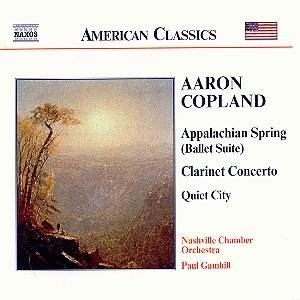That Aaron Copland is regarded as the quintessential
American composer is completely justified by the inclusivity of his
output. There is no other composer from the United States that better
represents the make-up of the American people in his music. Educated
in Europe, well traveled in Latin America, and the inventor of what
he dubbed the American vernacular style of composition, Coplandís works
express the diversity of his native land. His legitimization of both
the folk and jazz idioms by bringing them to the "classical"
concert hall is a contribution that would affect a number of his fellow
composers, Leonard Bernstein being the most notable among them.
What a find we have here in the Nashville Chamber Orchestra
and its exemplary lineup of soloists. An adolescent amongst performing
ensembles, this mere twelve-year-old stands out as an orchestra of maturity
and virtuosity. Active in the vital arena of the performance of music
by living composers, Paul Gambill and his band have commissioned and
premiered more than two-dozen new works. (Nota bene big five: this little
orchestra in the south is putting all of you to shame in the "music
of our time" department.) One can certainly hope that the worldwide
distribution might of Naxos will garner a great deal of attention for
this outstanding organization.
Nothing is more satisfying to a critic than to hail
a fine program, interestingly planned and excellently executed. And
that is exactly what we have here for the price of a combo meal at the
local fast food joint. Letís start off with the orchestral works. The
Three Latin American Sketches began life as two brief individual
pieces that the composer dismissed as unworthy of the concert repertoire.
It was not until André Kostelanetz commissioned a third piece
in 1971 that Copland revived his two earlier works, putting them together
in a suite ripe with the rhythm and color of Latin America. Played here
with verve and panache, these three minor scores make for a delightful
concert opener.
Appalachian Spring was written in 1944 for Martha
Grahamís dance troupe. This was the work that was to make Copland the
first American composer to gain international recognition. The music
went on to win both a Pulitzer Prize and a New York Criticís Circle
award, and is widely regarded as the finest example of Copland Americana
style of composition. The performance here is clean, sparse and elegant,
with just the right amount of nuance and a very appropriate lack of
sentimentality. The opening melancholy string passages are beautifully
hushed, and the faster rhythmic passages are precise and clear. The
Simple Gifts solo is played to perfection.
There are not sufficient superlatives to heap upon
soloist Laura Arden for this spectacular rendition of the concerto for
clarinet. Commissioned in 1947 by none other than Benny Goodman, the
great jazz man nearly let his exclusive rights to performance of this
work expire before he finally got up the nerve to play this fiendishly
difficult work in public. Of course, he did play the piece and recorded
it many times, twice with Copland himself conducting. This performance
is sheer perfection. Divided into two main sections, the concerto is
played without pause and is a tour de force for the solo instrument.
Opening with a long and mournful melody, Ms. Arden verily weeps through
her instrument, and one is lost in the beauty of both the tune itself
and her playing. There follows a monster of a cadenza and a fast movement
that is pure jazz with an orchestral accompaniment. Pushing the instrument
to the extremes of its range without a moment to breathe, Arden rips
through this incredibly difficult solo with a childís ease. She is a
world-class talent, and we hope to hear more from her soon!
Finally, we come to this writerís very favorite Copland
work, the achingly beautiful Quiet City. Paula Engerer and Scott
Moore are wonderfully expressive in their sedate and lonely solo passages.
Everything is in its place in this performance and one could not ask
for a better-balanced rendition. Everything that the composer wished
to depict in this picturesque score is brought to the fore, painted
on a broad canvas with exquisite colors and the finest of brushes.
Recorded sound is near perfect with a warm reverberant
acoustic and an excellent balance between the instruments and between
soloists and the orchestra. Viola Rothís program essay is concise, informative
and well structured. Recommended without a momentís hesitation.
Kevin Sutton
